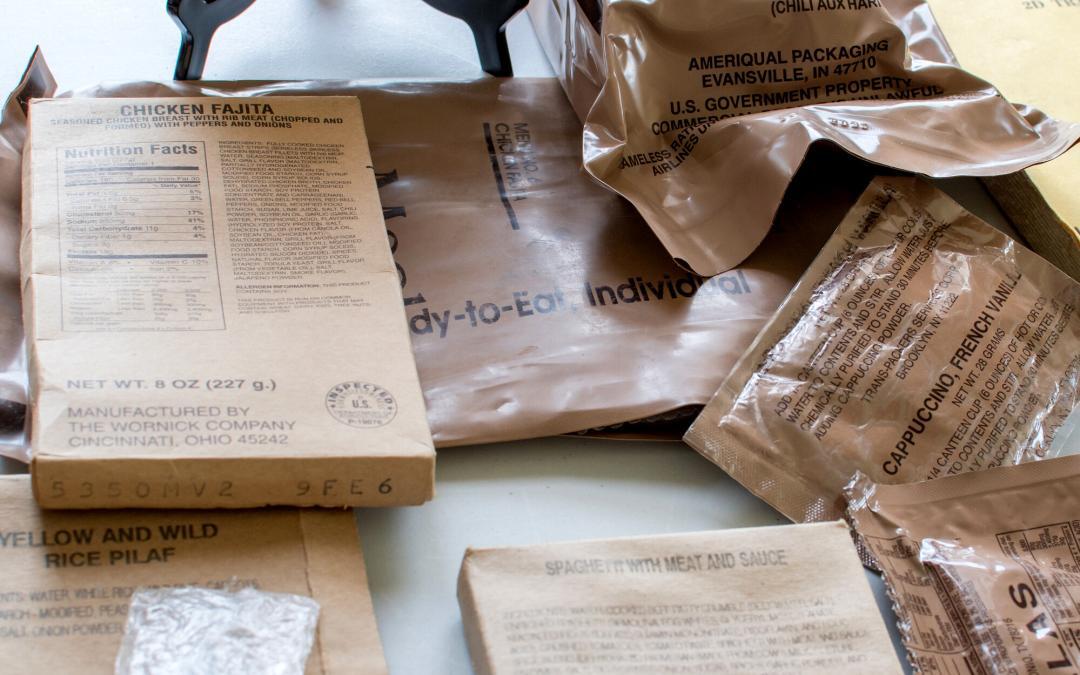
How Long Do MREs Last? The Truth About MREs
How long do MREs last is a crucial question for those planning to stock up on emergency rations or preparing for outdoor adventures.
MREs are the military’s go-to self-contained meals. They are complete meals in flexible bags, so you can eat without cooking in an emergency.
MREs can last for up to 5 years or more when stored at a temperature of 75°F or less. Storage conditions and the age of the MRE can affect their taste, texture, and nutritional value. It is recommended to rotate them regularly and replace any beyond their expiration date.
Read on as we’ll delve into the composition of MREs, their shelf life, and other important aspects.

In This Guide
- What Are MREs
- History Of MREs
- What Do MREs Contain
- Why Should I Stock Up On MREs
- MRE Labels And Meanings
- How To Determine The Expiration Date Of MREs
- MRE Shelf Life Chart
- How Do MREs Last So Long
- Can You Eat Expired MREs
- Signs Of Spoilage
What Are MREs?
An MRE, or Meal Ready-to-Eat, is a self-contained food package designed for quick and convenient nourishment. Military service members use MREs in situations that need a reliable food source.
They have been used during times of war or training for combat when other food was unavailable. Plus, MREs have been given out to civilians for daily rations during wars or after natural disasters for humanitarian relief.
They contain a pre-cooked meal packaged and sealed in airtight plastic pouches designed to be shelf-stable with a long shelf life and come as individual meals.
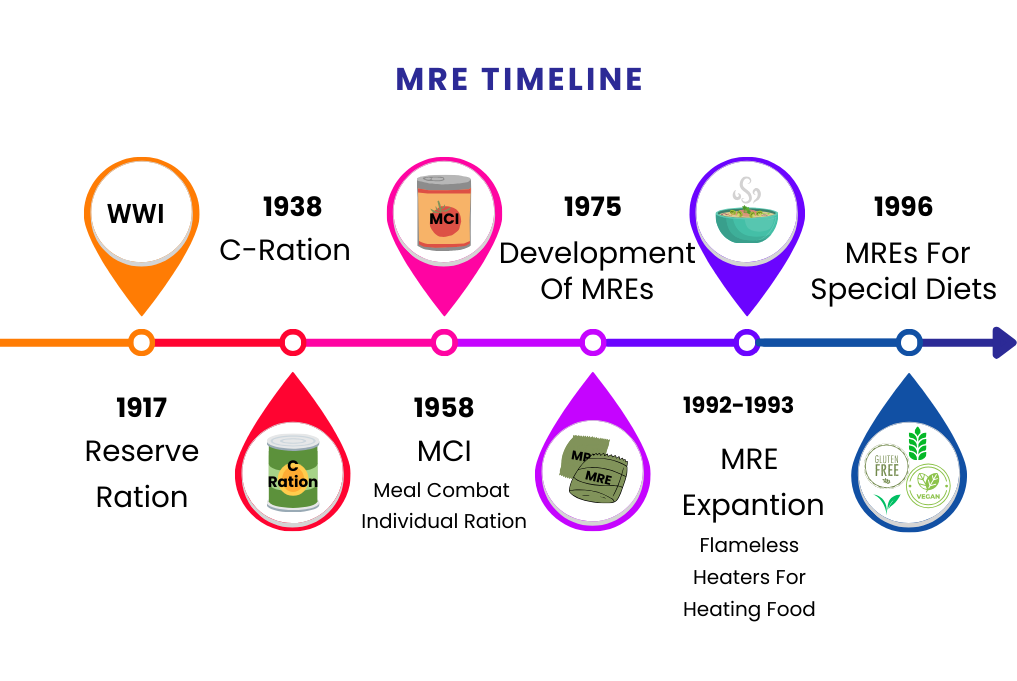
History Of MREs
MREs have seen significant improvements since their introduction in 1983, the US Military and Department of Defense have worked together to enhance their nutrition and taste.
Before MREs, soldiers had to rely on less popular food rations like “C Rations” (prepared wet food) and “Reserve Rations,” which lacked variety and nutritional adequacy. Reserve rations were used during WWI and usually consisted of hard tack biscuits and jerky.
The Meal, Combat, Individual (MCI) ration replaced C Rations in 1958 but was still disliked by soldiers. In 1975, the first MRE was developed, offering improved portability and nutrition, although taste and texture were initially not well-received.
Other versions, like the MRE-XIII addressed these issues by expanding menus and introducing new items. In 1992, the Flameless Ration Heater was introduced, increasing calorie intake for soldiers in the field.
Specialized diets like vegetarian and gluten free options were also included. Today, the Continuous Product Improvement (CPI) program collaborates with soldiers, dietitians, engineers, and scientists to refine MREs based on soldiers’ preferences and needs.
What Do MREs Contain?
Each MRE contains a main course, side dish, dessert, and various accessories like utensils or condiments. Most of them contain an entrée, side dish, dessert, snacks, candy, and a beverage mix. Some meals also include condiments like hot sauce and salt packets.
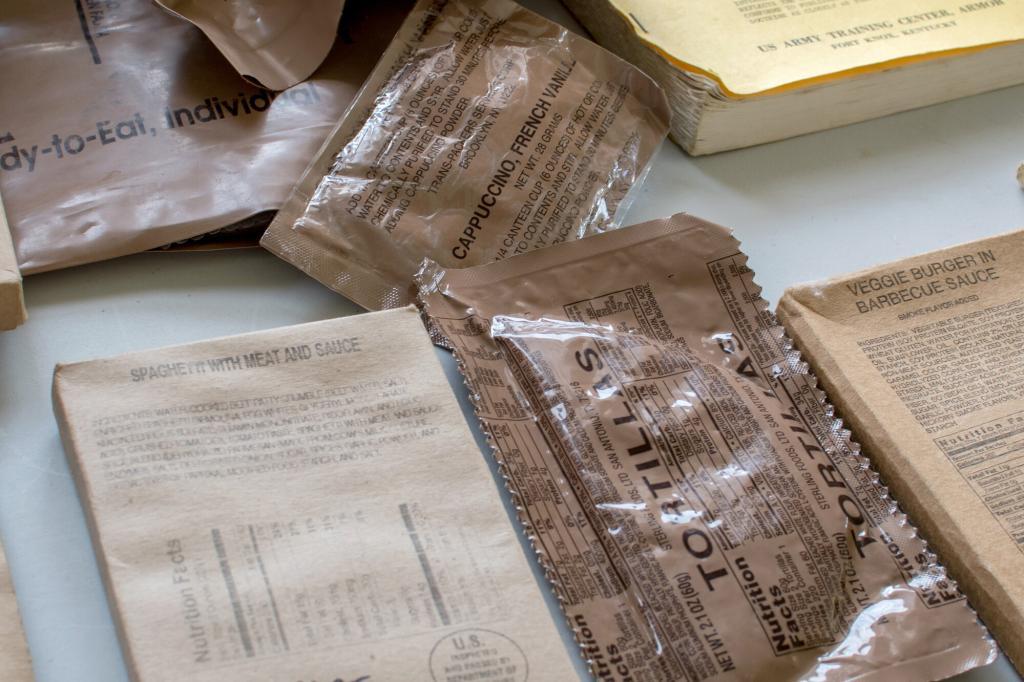
Why Should I Stock Up on MREs?
Stocking up on MREs provides a secure food supply for situations like natural disasters or prolonged outdoor activities. They’re lightweight, convenient, and last long. An MRE is handy since everything you need comes in one bag.
Also, it contains the essential nutrients to keep you nourished if you have no access to fresh food.
Some MREs come with amenities like toilet paper, which could be essential in emergencies. Some include flameless ration heaters to warm your meals when you don’t have access to a stove or grill.
While the military developed MREs for their troops, they are now available to the public. You can get them from anywhere, at any time of the day. But they are especially important during emergencies.
Now manufacturers offer more MRE options to meet different dietary needs. For instance, there are now low-sodium, gluten-free, and vegetarian MREs.
But, one drawback is that MREs are more costly than freeze dried alternatives. Other cons are that MREs are cumbersome and hard to find in supermarkets.
MREs can be purchased at army surplus stores, gun shows, eBay and Amazon. Be careful when purchasing because not all items labeled “MRE” are the true US military brands that your looking for. Plus, you always want to check the labels and dates.
MRE Labels And Their Meaning
MRE labels hold critical information regarding the food’s origins, nutritional content, and more importantly, its longevity. MRE manufacturers do not put traditional expiration dates with a day, month, and year. Their shelf life depends on how you store them.
Remember that the date on an MRE is not an expiration date but an inspection date. Instead, you’ll see the “production date” and “MRE inspection date” on the package.
Inspection Date
The inspection date on the MRE label indicates when the meal should be examined for quality and safety. This date might be three to five years after the packaging date. It depends on the product. It indicates when you should examine the food for signs of spoilage.
Manufacturing Date
The manufacturing date reveals when the MRE was created, a key factor in estimating its shelf life. The manufacturing date is a four-digit number. The first digit represents the year. The next three digits specify the day.
The downside is using a single digit to denote a year makes it difficult to tell between various decades.
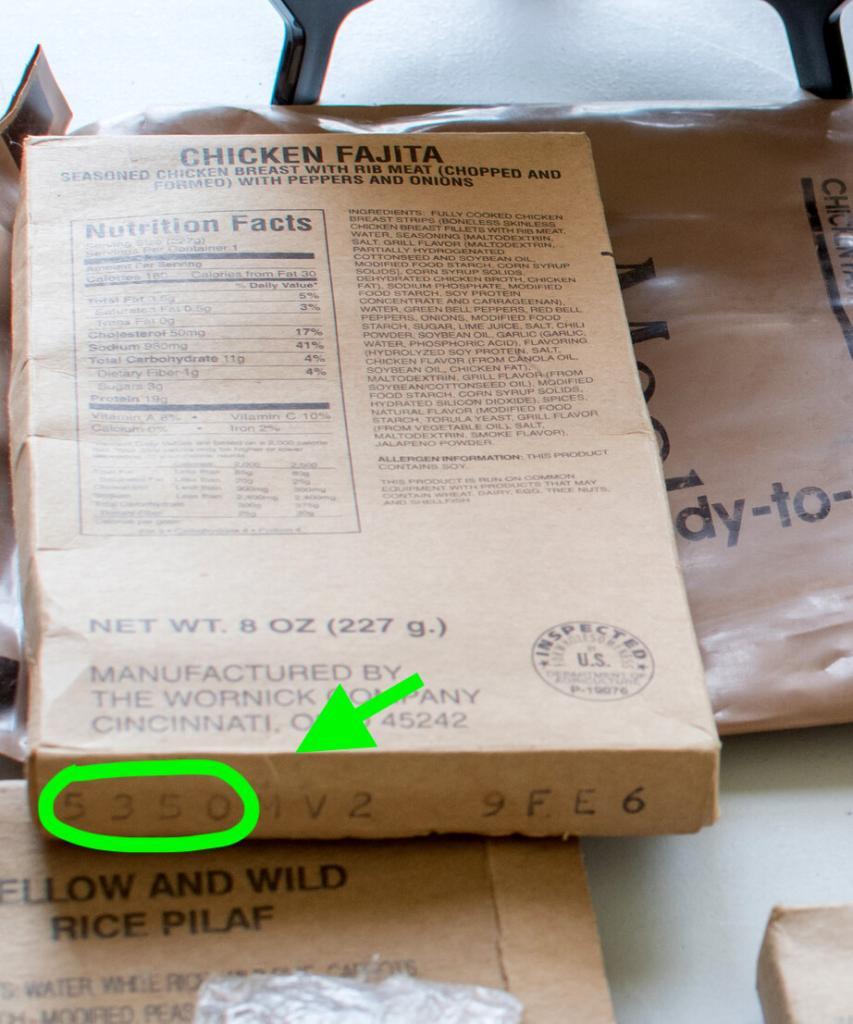
How to Determine the Expiration Date of MRE
Determining the expiration date of an MRE is crucial for safe consumption and effective planning. But if there is no expiration date, then when do MREs expire?
Well, MREs use a four-digit system called Julian’s Date to determine their expiry. This system originated in ancient Rome. Many companies also adopted this calendar system for dating their goods.
To make things easier, most people use an MRE expiration date calculator online, like the ones from MRE Info or Meal Kit Supply to determine an MRE’s age. But you can also figure it out yourself. Here’s how:
For example, the number 7068. The first “7” represents the year (2007). Then, the following three digits (out of 365 days a year) represent the day of the year of shipment. So, 7068 states March 9, 2007, which is day 68 of 2007.
MRE Shelf Life Chart
An MRE shelf life chart can serve as a helpful guide to understanding how long your food will last under varying conditions. MREs have a shelf life of five years as long as you store them well.
This chart provides an overview of how long MREs last after the inspection date:
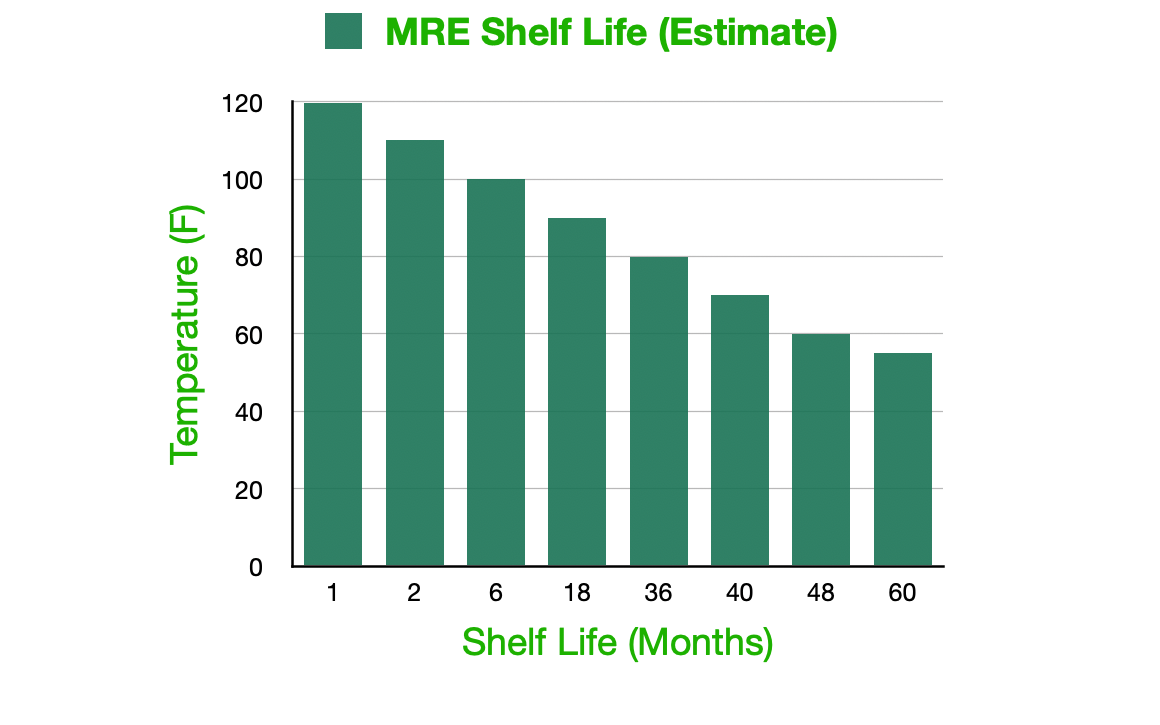
Some MRE cases come with a time and temperature indicator made of two concentric rings. The MRE has gone bad when the inner circle becomes darker than the outer circle. This means it’s over its expiration date due to exposure to high temperatures. (See the video below for more information.)
Knowing how long each meal will last is important if you are stocking up on MREs for an emergency.
Also, remember that certain ingredients in an MRE may go bad faster than others. Examples are cheese and other dairy-based products with a shorter shelf life.
H/T to @gschultz9 for the video: MRE Basics Time Temperature Indicator
How Do MREs Last So Long?
MREs are engineered to last for extended periods, thanks to unique preservation techniques and packaging. Before packing, manufacturers boil MREs to remove any remaining microorganisms.
The sterilization and packaging processes make MREs completely free of bacteria and contaminants.
These measures give MREs a longer shelf life than conventional food. So you can store them for years in a dark, cool place without going bad.
Some MREs have preservatives, although using much is less common than you may believe. Instead, MREs contain excessive amounts of salt. Salt acts as a natural disinfectant by drawing moisture out of bacterium cells.
MREs have more salt content than ordinary processed meals. That’s why you may store them longer without going bad.
Also, the MRE packaging contributes to their long shelf life. It inhibits the development of germs because of the container’s airtight nature. MRE packages are sterile until you open them.
Can You Eat Expired MREs?
It’s not recommended to eat expired MREs because eating past the expiration date can be dangerous. Expired MREs pose certain health risks, even if they may be edible under certain conditions.
Expired MREs may become contaminated with germs and microbes that can cause sickness. If an MRE has passed its expiration date, you should discard it immediately.
If you want to stock up on MREs, check their expiry dates to ensure you get edible food during emergencies.

Signs Of Spoilage
Obvious signs such as bad odor or discolored food indicate spoilage, so you should avoid consuming the MRE. Don’t consume the contents of your MRE packs if you see punctures, ruptures, or swelling.
Ruptures mean there’s a chance air got in and damaged the food. Bloated packaging is a sign that there are botulism-causing bacteria inside.
You should also discard your MRE if exposed to temperatures that might spoil the food. If you open your MRE and notice that the food smells or tastes off, throw it away.

Key Takeaways: How Long Do MREs Last?
Knowing how long MREs last is crucial for emergency preparedness and outdoor adventures.
Always check the expiration date if you decide to buy them. It’s always best to ensure you’ll have a reliable food source if needed.
With all this in mind, there’s no doubt that MREs can be an integral part of your prepping journey. With all this information, it’s time to stock up on MREs —so why not start today?
